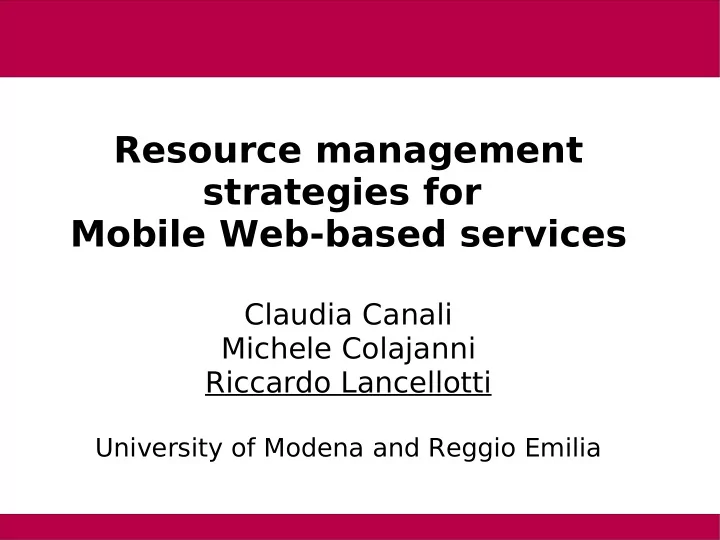

Resource management strategies for Mobile Web-based services Claudia Canali Michele Colajanni Riccardo Lancellotti University of Modena and Reggio Emilia
The mobile Web ● Web access form mobile devices – Access to services tailored to device ● On-the-fly adaptation ● Small display ● No keyboards – Services based on user preferences – Mobile Web increases the complexity of Web- based services ● Growth of mobile Web – Mobile users expected to grow by 900% within 2013 ● Will current architectures support future demands of mobile Web? October 12-14 Wimob 2008 - Avignon, France 2
Mobile Web-based services ● Focus on two significant categories of site – 80% of top 100 most popular sites ● Online news sites – Information portals (sports, economy) – Newspaper and news broadcasting sites (e.g., cnn.com) ● Social-multimedia sites – Web 2.0 sites – Social networking (e.g., Facebook, blogsphere) – Resource sharing networks (e.g., YouTube, Flickr) October 12-14 Wimob 2008 - Avignon, France 3
Workload evolution trends ● Workload composition ● Size of workload resources ● Workload intensity ● → Growth of computational demands October 12-14 Wimob 2008 - Avignon, France 4
Workload composition Online news Social multimedia 100% 100% 90% 90% 80% 80% 70% 70% 60% 60% Audio/Video Audio/Video 50% Images 50% Images Text Text 40% 40% 30% 30% 20% 20% 10% 10% 0% 0% 2008 2013 2008 2013 Growing amount of multimedia resources October 12-14 Wimob 2008 - Avignon, France 5
Size of workload resources ● Resources are getting larger – Picture size – Video resolution and length ● Growth of median resource size – 12% per year for images – 16% per year for audio and video October 12-14 Wimob 2008 - Avignon, France 6
Workload intensity ● Growth of workload intensity – Low growth scenario 60 ● 20%-40% per year 50 – High growth scenario 40 ● 35%-55% per year Low growth 30 High growth ● Moore's law: 20 – Computational power 10 doubles every 18 months – Is it enough? 0 Online News Social Multimedia October 12-14 Wimob 2008 - Avignon, France 7
Experimental testbed Mobile Web Workload Clients model Internet Server ● Simulation based on Omnet++ with Inet package ● Server model: – Working set description (type and size of resources) – Dynamic services (depends on resource size and CPU) – Internal server resources (time shared CPU) – HTTP 1.1 interactions (chucked downloads and uploads) ● Mobile Web clients (workload intensity based on clients) – Use of HTTP streaming for multimedia resources October 12-14 Wimob 2008 - Avignon, France 8
Experimental scenarios ● Current scenario – Nowadays workload models – Current CPUs ● Low-growth scenario – Conservative assumptions on workload evolution – Future CPUs ● High-growth scenario – Worst-case for supporting architectures October 12-14 Wimob 2008 - Avignon, France 9
Performance impact Response time Online news Social multimedia CPU power growing more than CPU power growing less than workload workload October 12-14 Wimob 2008 - Avignon, France 10
CPU Utilization 1,2 1 0,8 Current 0,6 Low growth High growth 0,4 0,2 0 Online News Social Multimedia CPU overload occurring in 3 out of 4 scenarios October 12-14 Wimob 2008 - Avignon, France 11
Resource management strategies ● Need to reduce computational demand ● Avoid adaptation of multimedia resources on-the-fly ● → Pre-generation of multimedia content ● Pre-generating every content – Not every resource can be pre-generated – Highly volatile workload – High computational and storage demands – → Unfeasible October 12-14 Wimob 2008 - Avignon, France 12
Resource management strategies ● Pre-generating a fraction of the contents – Focus only on the most popular resources – Exploit Zipf-like popularity distribution – How much pre-generation is required? ● Workload characteristics: – No clear model for popularity distribution – Zipf α parameter ● From 0.8 (typical Web workload) ● To 1.0 (highly skewed workload) October 12-14 Wimob 2008 - Avignon, France 13
Performance impact Online news: High growth October 12-14 Wimob 2008 - Avignon, France 14
Performance impact Social multimedia Low growth High growth Pre-generating up to 15% is good for most scenarios October 12-14 Wimob 2008 - Avignon, France 15
CPU Utilization High growth scenario 1,2 1 0,8 Online News 0,6 Social Multimedia 0,4 0,2 0 0% 5% 10% 15% 20% 25% 30% October 12-14 Wimob 2008 - Avignon, France 16
Conclusion and open problems ● Focus on Mobile Web ● Workload evolution 2008 → 2013 – Social networking + Multimedia will be the killer application of future mobile Web – Computational demand will grow faster than CPU power in most considered scenarios ● Possible solution: pre-generating the most popular resources – 5%-15% of the working set may be sufficient ● Open problem: identifying the popular resources – Highly volatile workload (the read-write Internet) – Short resource life span (~ 24-48 hours) – Need for early detection of popular resources October 12-14 Wimob 2008 - Avignon, France 17
Resource management strategies for Mobile Web-based services Claudia Canali Michele Colajanni Riccardo Lancellotti University of Modena and Reggio Emilia
Recommend
More recommend